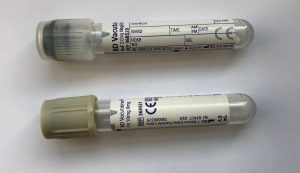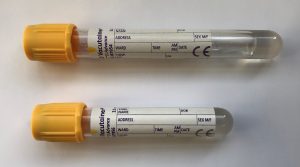Fluoride oxalate for ethylene glycol and serum for ‘poison profile’


If suspicion of ethylene glycol ingestion, request ethylene glycol AND ‘poisoning profile’ which contains:
The poison profile results will be used by the Duty Biochemist to determine whether the ethylene glycol should be sent. Phone the Duty biochemist (DB) on ext 2935 or Bleep via switchboard outside normal working hours. If required, the Duty Biochemist will arrange for the ethylene glycol sample to be packaged up, contact the referral laboratory (City Hospital, Birmingham) and arrange for a taxi via switchboard for sample collection.
Toxic range:
The lethal dose of ethylene glycol in a 70 kg adult is ~100 g (about 90 mL pure ethylene glycol), but as little as 30 mL may be fatal.
Diethylene glycol is also reported.
Limit of quantification: 25 mg/L (ethylene glycol & diethylene glycol)
Overview Ethylene glycol poisoning is considered a medical emergency. Despite being recognized as a poison for nearly 50 years, ethylene glycol remains readily available and continues to be fatally ingested. The most common sources of ethylene glycol are automotive antifreeze (generally available as a 95% concentration), engine coolants and hydraulic brake fluids.
In ethylene glycol poisoning, the clinical course is initially characterized by mild symptoms that may gradually develop to produce serious or even fatal toxicity. Ethylene glycol poisoning presents many challenges in making a definitive diagnosis. If treatment is initiated early, prognosis is excellent.
Morbidity and mortality for ethylene glycol poisoning is related to delay in treatment, so treatment for real or suspected ethylene glycol poisoning should not be delayed awaiting laboratory confirmation of ingestion.
Referred test
1 day
Can be added on to an existing request up to 4 days following sample receipt
City Hospital, Birmingham
Specimen Labelling Procedure